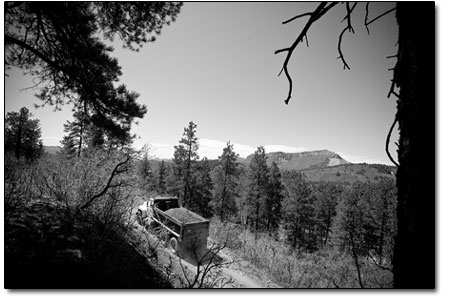| ||
| The road to Log Chutes Logging road to replace singletrack SideStory: Resolution on Animas? BLM takes ‘careful’ approach to controversial project
by Will Sands One of Durango’s most popular trail systems is going back beneath the blade. Logging has returned to the Log Chutes area, and many miles of singletrack will go back to being active logging roads as a result. Last week, the Forest Service kicked off a project that will thin nearly 900 acres approximately 5 miles north of Durango. In an effort to reduce the risk of wildfire, the agency will use a combination of hydromowing and commercial logging in the Log Chutes area. The logging will require the presence of trucks, and 4 miles of trail that were once old roads are scheduled to be cleared, bladed and reconstructed. The roads in question comprise the entire uphill of the trail system’s approximately 7-mile outer loop. In addition, another 1.95 miles of new, temporary roads also will be built to create access for logging and mowing. The San Juan Public Lands Center has explained that turning trail back into road is the most cost-effective way to conduct the project. The agency added that when the Log Chutes Trail System was created it was with the understanding that logging would someday return to the area. “The whole area was once filled with logging roads,” explained Richard Speegle, recreation project manager for the San Juan National Forest. “That’s why it’s known as Log Chutes. Now we’re going back in and turning many of those singletrack trails back into roads.” Craig Goodell, fire mitigation and education specialist for the San Juan Public Lands Center, commented that historic logging is actually one of the reasons that Log Chutes needs to be treated. “In the Log Chutes area, the ponderosa pine stand is really denser than would be considered natural,” he said. “The area was logged really heavily around the turn of the century, and the secondary growth is really too thick to be healthy.” As a small concession to trail users, the agency plans on closing only small sections of Log Chutes at any given time and allowing hiking and mountain biking to continue throughout the summer. When the work is complete, the Forest Service plans to reseed and rehabilitate the roads. “As far as the agency is concerned, it’s an old logging road system, and we’re just going back in,” Speegle said. “The intent will be to let the roads go back to being trails, but the Forest Service is just going to let nature take its course. We’re not going in there and specifically rehabilitating the roads into trails.” Local trails advocacy group Trails 2000 has been involved in the planning for the thinning of the Log Chutes area for years. The group has always maintained the stance that logging the area will have a major impact on recreation but is a necessary evil and will mitigate wildfire risk near neighborhoods. Mary Monroe, the group’s executive director, commented, “It’s our understanding that the logging that will happen in Log Chutes will have a pretty big impact on the trail network We’re hoping that by working with the Forest Service, we will be able to help rehabilitate those roads back into singletrack.” However, with major road construction occurring on a large amount of the trail system, the singletrack may not be brought back to life for many years. “We’ll just have to look forward to the time when those roads can go back to being trails,” Monroe said. The Forest Service looked to the past while formulating the current plan to thin the Log Chutes area. In the summer of 2002, 15,770 separate wildfires burned more that 1.2 million acres throughout the West. Among the blazes was Durango’s devastating Missionary Ridge Fire, which charred nearly 71,000 acres north of town and claimed 56 homes. In 2003, the Bush administration responded with the Healthy Forests Restoration Act, and the National Fire Plan was born. Among the plan’s mandates is that the Forest Service thin trees in the wildland urban interface, the edge of the forest in proximity to communities and homes. Log Chutes qualifies as part of that interface. “Ideally we’d treat every place in order to restore the forest ecosystem and mitigate against wildfire,” Goodell said. “But we have a limited amount of money to work with, and so treating within the urban interface, where human life and property are at stake, is the priority.” However, the wildland urban interface also tends to be an area popular with local trail users. Two summers ago, a fuels-mitigation effort north of Durango in Hidden Valley raised objections. In addition, a proposal to log Animas Mountain has drawn fire from hikers and cyclists. With Log Chutes, the Forest Service did its best to address public concerns up front, according to Speegle. The agency conducted an extensive public scoping three years ago but turned up a surprising lack of public interest. “We beat the bushes and tried to get the word out three years ago,” Speegle said. “There might have been other things going on or maybe it was under the radar, but we got absolutely no response.” Logging has already gotten under way at Log Chutes. The entire thinning project is expected to last through mid-summer.
|


